
Maintaining your backyard pond keeps it clean and in good condition. Learn how much pond maintenance costs and what factors can affect the price.
Make a splash with one of these yard upgrades


Fountains can cost as little as $20, especially if you DIY. Most ponds begin at a few hundred dollars and can cost as much as $50,000 or more.
Fountains offer more variability than ponds design-wise, coming in various styles and materials.
Fountains can take up very little space, whereas ponds require a bit more room.
Ponds require more maintenance than fountains, especially with fish or plants.
Fountains provide soothing sounds, whereas ponds are quieter.
Watch sunlight glint off the still surface of a pond, listen to the splash of a fountain, and feel instantly transported and relaxed. For a dose of serenity and to enhance the beauty of your property, add a water feature. When it comes to ponds versus fountains, which is a better choice for your home? Here’s a head-to-head comparison to help you decide.
Ponds and fountains are similar but have a few key differences. Ponds are considered their own ecosystem, complete with vegetation and wildlife (think: koi pond ideas). They’re larger than fountains, consisting of a flat, spread-out, and water-filled expanse. While they may include a decorative waterfall, ponds don’t have much height.
On the other hand, fountains are not a biological system and don’t contain wildlife or vegetation. They’re smaller, more affordable, quicker to install, and simpler to maintain. Fountains always include some element of flowing water, be it a tiered tower, urns, or some sort of decorative spray that provides height.
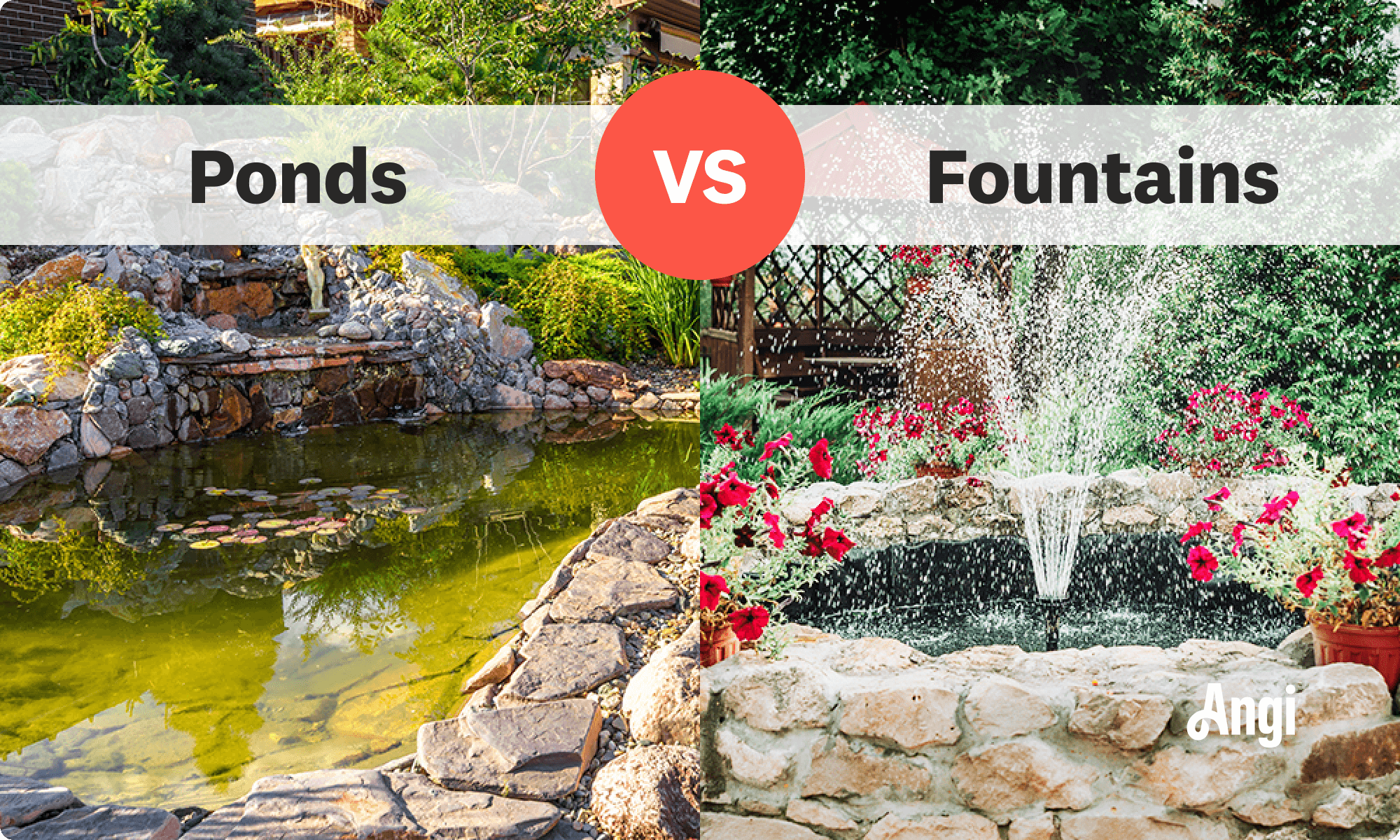

When it comes to water features, fountains are the most elemental. These sources of serene sounds include a reservoir of water, a pump, tubing, and a basin. Besides being cost-effective, fountains are easier to maintain than ponds and can work in the tiniest spaces. For the lowest maintenance design, install one with an underground water reservoir.
| Pros | Cons |
|---|---|
| Options for every budget | Still requires upkeep |
| Can be DIY-friendly | Pumps and filters can clog |
| Great for small spaces | Certain models can be expensive |
| Less maintenance | Too small for fish |
You can find a fountain on any budget, from $20 to $10,000. Outdoor water fountains cost between $150 and $500 or up to $2,000 for a 7-foot-tall cast concrete model. If you DIY, your investment could be a few dollars. Just use a stack of rocks, an old planter, and a pump or stick a bubbler in a birdbath. The only requirement for the basin is to drill a hole in its base for the waterline.
Many fountains are easy enough to install yourself. You should be able to complete the project in a few hours versus the several days or weeks required for a pond. You’ll probably need to hire a fountain installer to put in a bigger, heavier model with a reservoir, but you shouldn’t need to secure a building permit or install a fence.
Since fountains are small, they can fit on tiny patios and postcard-sized yards.
Fountains require less maintenance since they’re smaller than ponds. For the least amount of work, go with a pondless model. Since leaves can't collect in the reservoir, you won’t need to worry about cleaning out debris.
In design, fountains run the gamut from 6-foot tiered towers to orbs and vases. They also come in various colors and materials, from glazed ceramic to cast concrete and fiberglass.
From gentle burbling to pouring and splashing, fountains offer different calming sound options.
Fountains are smaller than ponds and often make less of a visual impact. That said, you can go with a 6-foot-tall model that will make more of a splash.
Fountains are too small and shallow for fish to call home. Meanwhile, you can incorporate more life forms with ponds, like lily pads, frogs, and koi fish. If you install a bubbler in your fountain, it will likely attract birds and butterflies.
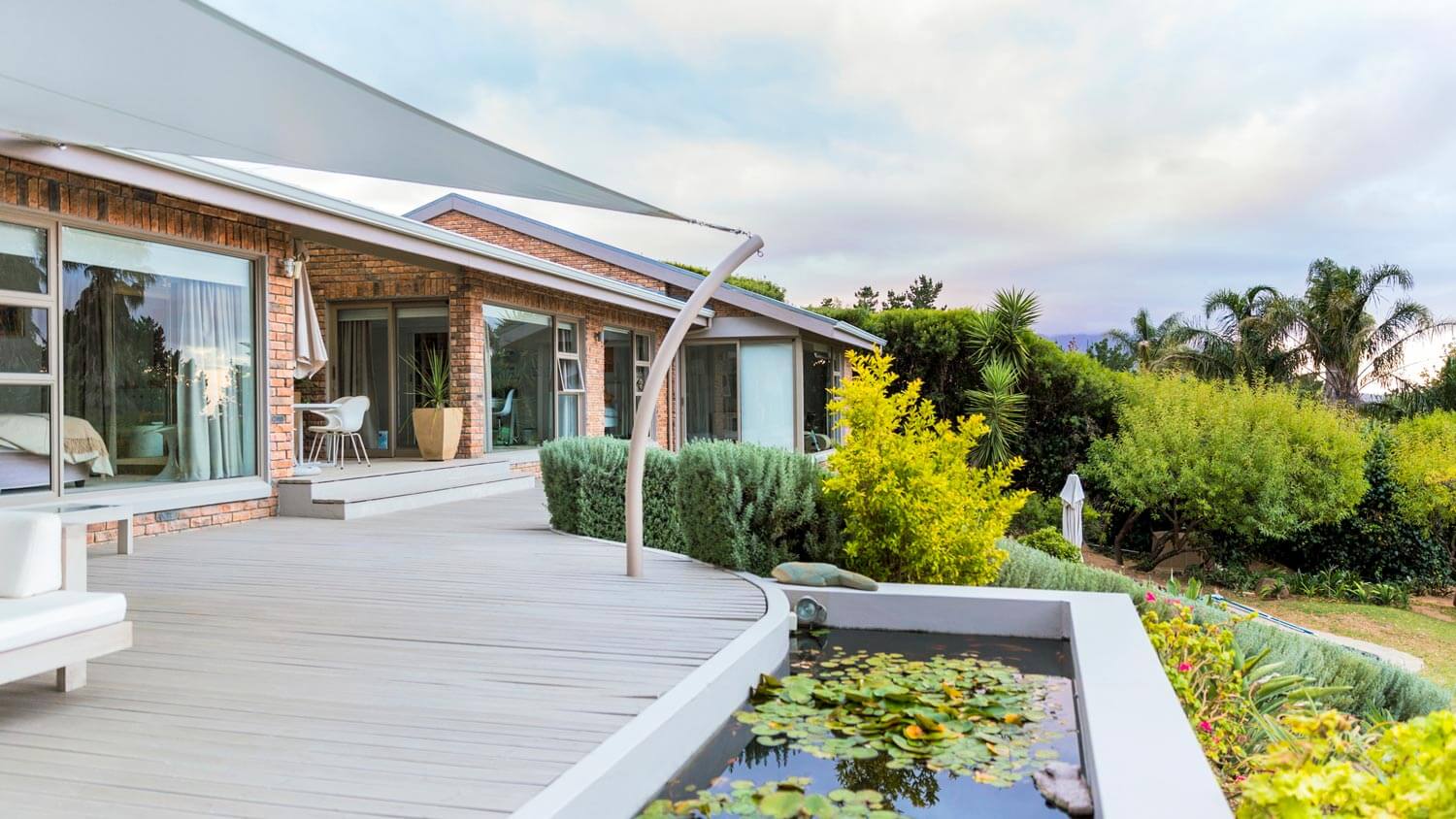
Ponds include an underlayment, liner, filter, and pump in addition to the water. Since they’re larger than fountains, they make more of a visual statement. Plus, they can shelter a variety of wildlife. Unfortunately, these more complicated water features are pricier to install and maintain.
| Pros | Cons |
|---|---|
| Suitable for fish and other wildlife | Complicated installation |
| Large size makes a striking visual impact | May not be suitable for small spaces |
| Some ponds are big enough for boating and swimming | High cost depending on size |
| Can increase property value | Requires more maintenance |
In most cases, ponds are bigger than fountains and will give you a tranquil view from different vantage points on your property. If you have the room and budget, put in a pond deep enough to support fish and to make a major visual impact. A significant budget could even accommodate a pond large enough for boating.
You can sustain koi, other fish, frogs, and plants by installing a pond. To help maintain your koi pond, hire a local koi pond service.
Add a waterfall, rock wall, or extensive plantings for more drama and beauty.
You can buy a kit with a rigid plastic tub, tubing, and a pump for a 9-square-foot, 84-gallon pond for as little as $70. However, expect to pay at least $5,000 for a 176-square-footer installed by a pro and up to $50,000 for more elaborate versions.
If your pond will be deeper than 18 inches and longer than 6 feet on at least one side, hire a local pond company. Even if your pond is small, you’ll need to bring on a plumber and an electrician—that way, you’ll be sure to avoid any water, sewer, or electrical lines. Plus, there’s a good chance you’ll need to obtain a building permit and install a fence with a locking gate. Even with an experienced team, many ponds take several days or weeks to install.
To put in a pond, you need a more sizable area than you do for a fountain. Some yards are too small and not level enough. If you plan to stock your pond with fish, make your pond at least 24 inches deep or 36 inches deep in colder climates.
To reduce algae growth, situate your pond to receive sunlight in the morning and shade in the afternoon. Depending on local building codes, you might need to set your pond back a certain amount of feet from property lines. You’ll also need to call 811 to ensure your chosen site won’t disturb existing utility lines.
Ponds tend to be more costly and time-consuming to maintain than fountains. Ponds are bigger and hold more water, requiring more time to remove debris. Koi pond maintenance also requires extra steps. If you use city water, you’ll need to add a de-chlorinator directly to the water.
Ponds don’t offer as many distinct looks as fountains. Forget modern or contemporary looks—ponds are more about organic, natural beauty.
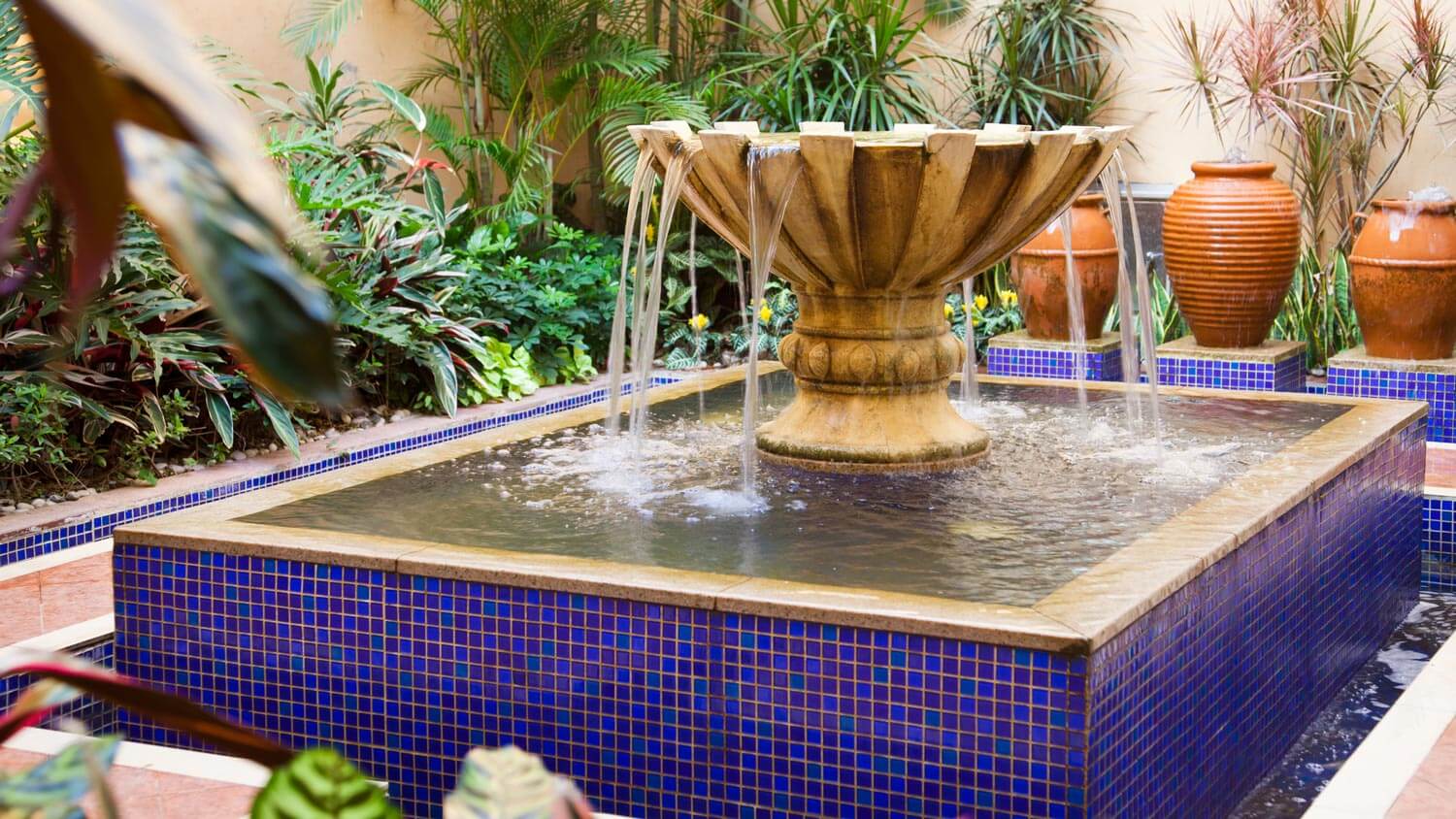
Which type of water feature is best for your home? It depends on your needs and circumstances. Let’s look at how each option performs in a head-to-head battle.
Fountains cost hundreds or thousands less than ponds. The cost to build a pond is $3,400 on average, but a large pond could cost between $15,000 and $25,000. In contrast, the average fountain costs $2,725. Even at the high end, most homeowners only spend around $11,800.
When it comes to water feature installation, a fountain is the quickest and simplest to install. A pro can install a fountain in a few hours. Ponds, however, can take weeks to install, requiring serious excavation and potentially significant yard regrading to level the land. After installation, it can take a few weeks for your pond to settle and naturally fill with water, though depending on the type of pond, you can truck in water or fill it with a hose.
Fountains are less pricey and time-consuming to maintain than ponds. For most homeowners, pond maintenance costs $400 to $5,000 per year, and maintenance could include everything from feeding fish and dechlorinating water to planting, cleaning your pond, managing algae levels, and pump or filter repairs.
Fountain maintenance costs about $240 to $1,800 per year. You’ll also need to clean your fountain so debris doesn’t clog the pump or filters and make repairs to components when necessary.
Though there are ponds and fountains of all sizes, you’ll need more space to install a pond. The tiniest fountains may only require 1 or 2 square feet of space—not much more than a large planter. You can easily tuck a fountain into an existing garden, whereas the average pond requires around 150 square feet of space.
The sky’s the limit with fountains, which you can purchase in various styles and materials. Fountains also allow you to get creative with your landscaping. You can plant flowers in mulch and easily add a small fountain as an accent. You can make a fountain the centerpiece of a hardscaping feature, like a circular driveway or patio. You can even add a fountain inside of a pond.
Beyond that, there are fountains of all different heights—from those that spray water in decorative patterns to those with a gentle trickle of water cascading down sculptural towers or vases.
Fountains offer a range of sound options, from burbling to pouring and splashing. It depends on the type of water feature, but options are plentiful. Some fountains bubble, while others flow or spray. That’s not to say ponds have no sound effects. They can offer nature sounds, like chirping frogs on summer nights (though there’s no guarantee). You can also install a waterfall to have the peaceful sound of flowing water.
You can go as big as you like (and as big as your budget will allow) with ponds. Meanwhile, fountains are much smaller in scale. What they don’t offer in width, they offer in height. You can add height to a pond with a waterfall, strategically placed boulders, or taller vegetation.
A water feature contractor near you can help you reach your goals, design a pond for your space, and make your backyard dreams a reality.
Ponds can support fish, plants, frogs, turtles, dragonflies, and other beneficial creatures. They also attract birds, who feed on the insects that grow within the pond. You can fill them or surround them with native plants that help support biodiversity and attract pollinators. Fountains, on the other hand, are too small and shallow to shelter flora and fauna.
When it comes to fountains versus ponds, fountains win for their versatility. They’re a better option for price, ease of maintenance, space, and design options. While ponds lean rustic, fountains work with different design styles, from contemporary and modern to classic and minimalist. You can even install a rustic fountain or one that feels more maximalist.
The right choice depends on your needs and wants. Ponds are a clear winner for anyone who wants to create an ecosystem in their backyard, raise fish, or plant an aquatic garden. They’re also a winner if you want to change your landscape in a big way.
Dina Cheney contributed to this piece.
From average costs to expert advice, get all the answers you need to get your job done.

Maintaining your backyard pond keeps it clean and in good condition. Learn how much pond maintenance costs and what factors can affect the price.

You may need to fill in a backyard pond to reclaim your yard or to remove an eyesore. Learn how much it costs to remove a pond and what affects the price.
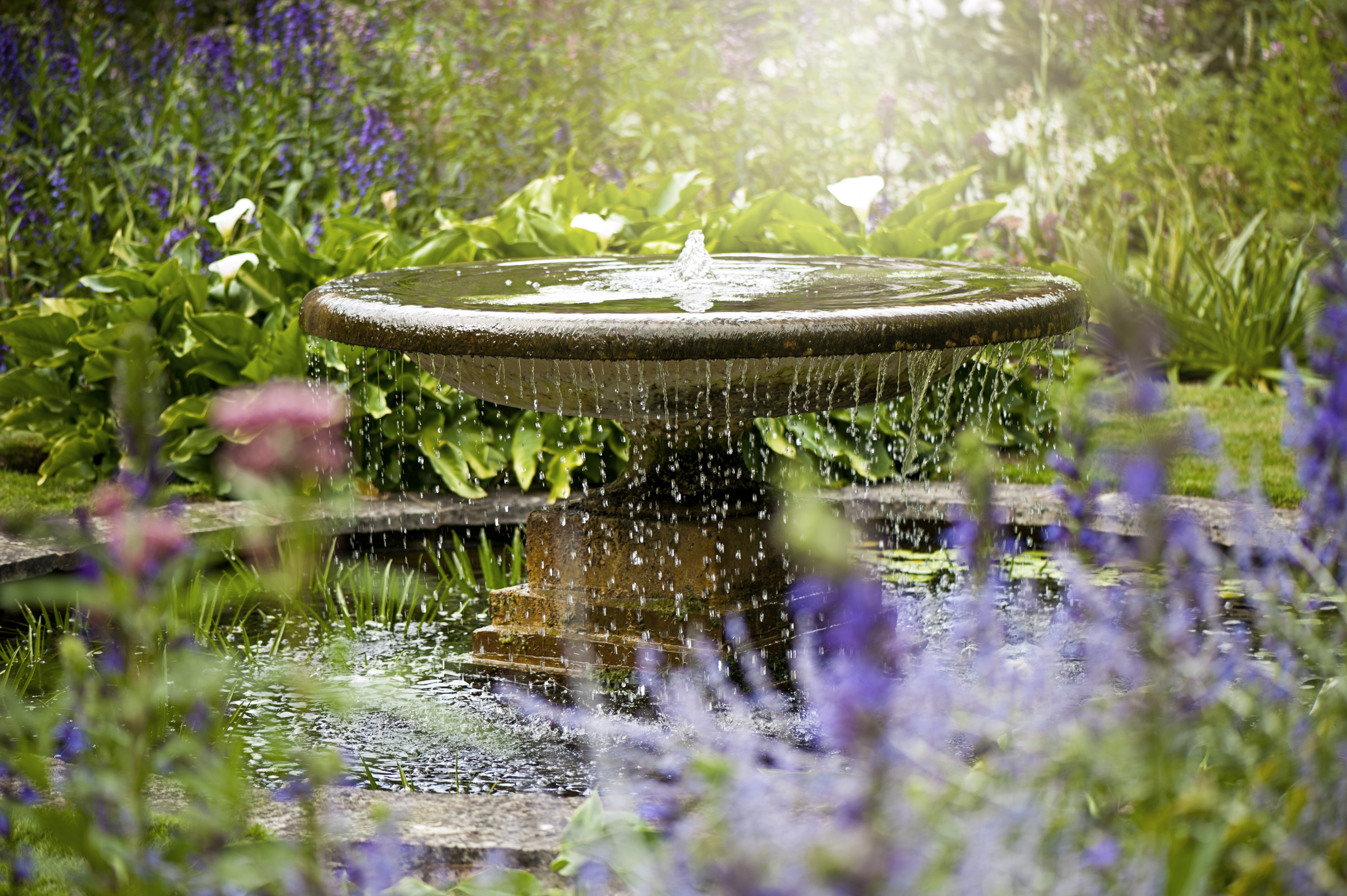
Discover the average outdoor water fountain installation cost, including key price factors and tips to help you budget for your project.
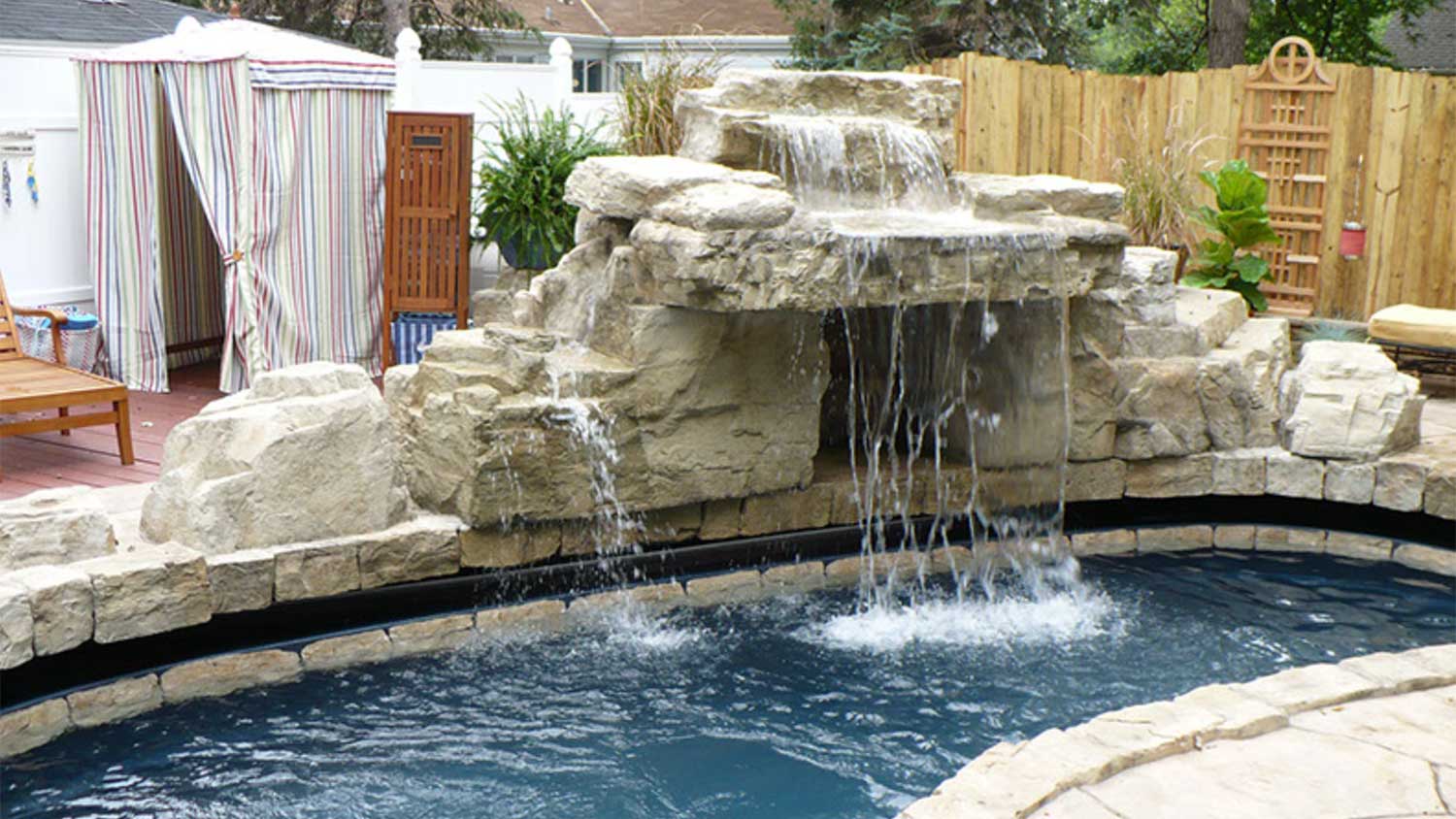
Discover the cost to add a waterfall to a pool. Learn about average prices, cost factors, and ways to save on your pool waterfall installation.

Regular outdoor fountain maintenance will keep your water feature looking and working great. Follow these tips to learn how.
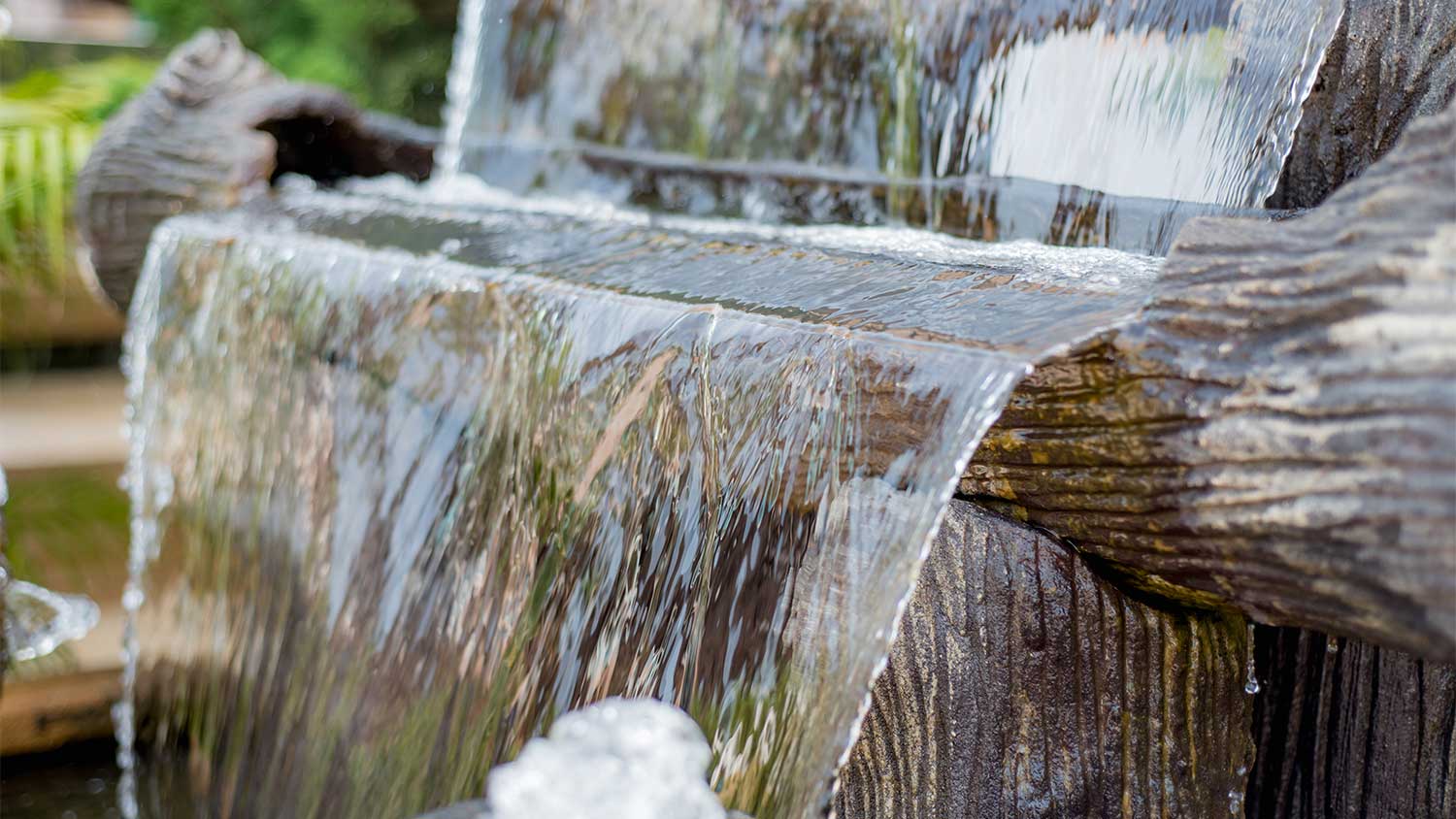
Discover how much it costs to install a pondless waterfall, including average prices, key cost factors, and tips to save on your water feature project.